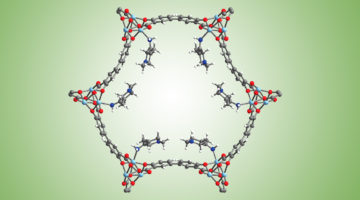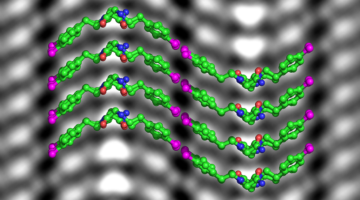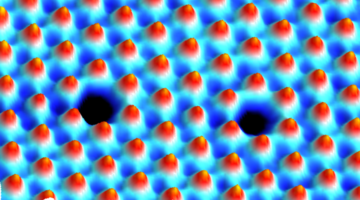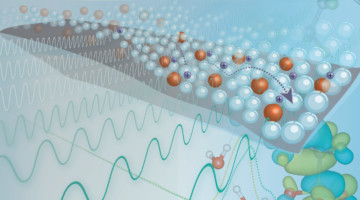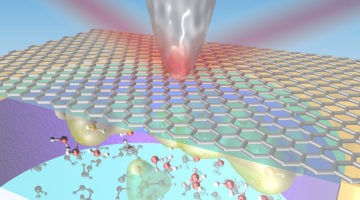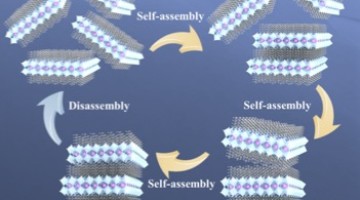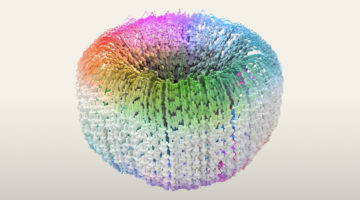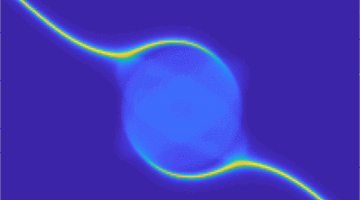With the help of the ALS, researchers from UC Berkeley and ExxonMobil fine-tuned a material to capture CO2 in the presence of water. The parties have applied for a patent on the material, which was developed for use on the relatively humid flue gases emitted by certain natural gas power plants, a cleaner-burning alternative to coal. Read more »![]()
![]()
Turning Up the Heat on Antibacterial-Resistant Diseases
Scientists have designed a biocompatible polymer that has the potential to advance photothermal therapy, a technique that deploys near-infrared light to combat antibacterial-resistant infections and cancer. The team synthesized the polymer by stringing together small molecules called ionic azaquinodimethanes, which they characterized at the ALS. Read more »
Freeze Frame: Scientists Capture Atomic-Scale Snapshots of Artificial Proteins
Protein-like molecules called polypeptoids have great promise as precision building blocks for creating a variety of designer nanomaterials. In this study, rsearchers used cryo-EM, a technique originally designed to image proteins in solution, as well as x-ray scattering techniques, to characterize the structure of polypeptide nanosheets. Read more »
The Beauty of Imperfections: Linking Atomic Defects to 2D Materials’ Electronic Properties
Two studies reveal surprising details on how some atomic defects emerge in transition metal dichalcogenides (TMDs), and how those defects shape the material’s electronic properties. The findings could provide a more platform for designing 2D materials for quantum information science and smaller, more powerful optoelectronics. Read more »
Go With the Flow: Scientists Design Better Batteries for a Renewable Energy Grid
Researchers developed a versatile yet affordable battery membrane—from a class of polymers known as AquaPIMs. This class of polymers makes long-lasting and low-cost grid batteries possible based solely on readily available materials such as zinc, iron, and water. Read more »
Multimodal Study of Ion-Conducting Membranes
Using multiple x-ray characterization tools, researchers showed how chemical and structural changes improve the performance of a novel ion-conducting polymer (ionomer) membrane from 3M Company. The work provides insight into factors impacting the proton conductivity of ionomers used for fuel cells and the production of hydrogen fuel. Read more »![]()
![]()
Infrared Nanospectroscopy at Graphene–Liquid Interfaces
Researchers developed a new infrared approach to probing the first few molecular layers of a liquid in contact with a graphene electrode under operating conditions. The work offers a new way to study the interfaces that are key to understanding batteries, corrosion, and other bio- and electrochemical phenomena. Read more »![]()
![]()
Self-Assembling Nanomaterials Are Organized and Tunable
Perovskite superlattices have a wide variety of applications, but they are difficult to synthesize. Researchers have now characterized their self-assembly process to better understand how to create a variety of superlattice materials. Read more »
Electric Dipoles Form Chiral Skyrmions
Researchers demonstrated that polar skyrmions—cousins of magnetic skyrmions but comprising swirls of electric dipoles instead of spins—exhibit chirality in a material with electrically switchable properties. Control of such phenomena could one day lead to low-power, nonvolatile data storage as well as to high-performance computers. Read more »![]()
![]()
Chiral Crystals Give Rise to Topological Conductors
Researchers have discovered materials whose chiral crystal structures produce chirality in their electronic behavior. These topological conductors retain their unique electronic properties regardless of defects and open new possibilities in materials research. Read more »
- « Previous Page
- 1
- …
- 5
- 6
- 7
- 8
- 9
- 10
- Next Page »
